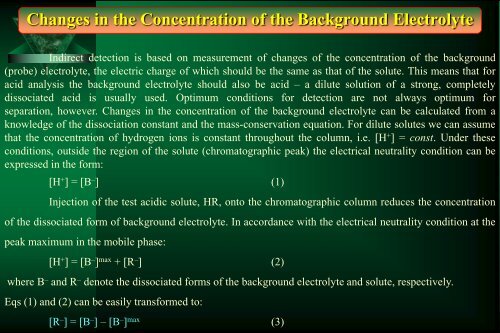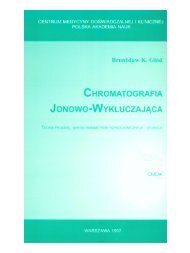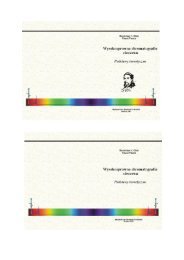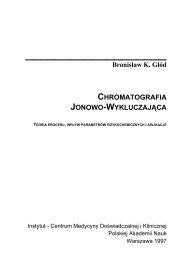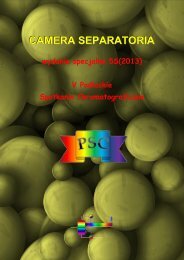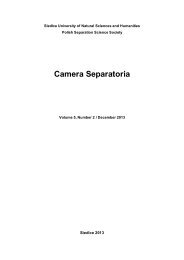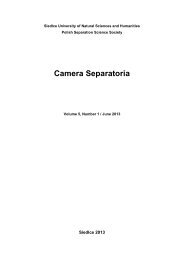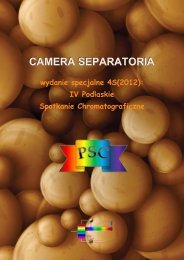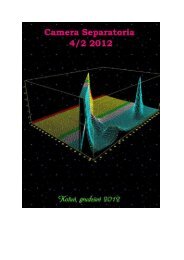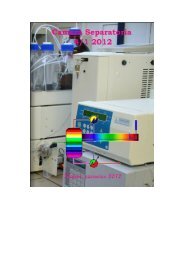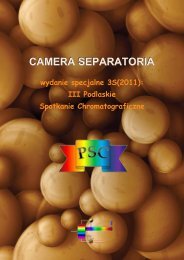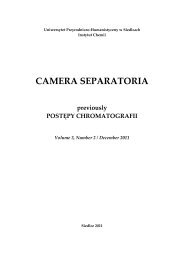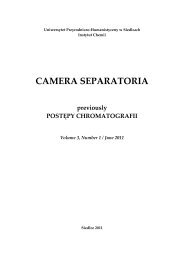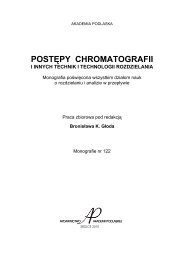- Page 1 and 2:
Wysokosprawna Chromatografia Cieczo
- Page 3 and 4:
Rozdzielanie Adsorpcja Analiza sito
- Page 5 and 6:
Rozdzielanie
- Page 7 and 8:
Michaił Sjemjonowicz Cwiet
- Page 10 and 11:
Michaił Sjemjonowicz Cwiet
- Page 12 and 13:
Pierwsze chromatografy cieczowe
- Page 14 and 15:
Pierwsze chromatografy cieczowe
- Page 16 and 17:
Historia chromatografii 1903 - Cwie
- Page 18 and 19:
Techniki rozdzielania i ekstrakcji
- Page 20 and 21:
Techniki rozdzielania i ekstrakcji
- Page 22 and 23:
Spektrometr mas Nobel Prizes in Mas
- Page 24 and 25:
8. Chromatografia wykluczania stery
- Page 26 and 27:
Podział Chromatografii Wszystkie t
- Page 28 and 29:
Podział Chromatografii
- Page 30 and 31:
Podział Chromatografii
- Page 32 and 33:
Rugowanie
- Page 34 and 35:
Ekstrakcja do ciała stałego
- Page 36 and 37:
Podział Chromatografii Cieczowej 1
- Page 38 and 39:
Podział Chromatografii Cieczowej M
- Page 40 and 41:
Podział Kolumnowej Chromatografii
- Page 42 and 43:
Podział Kolumnowej Chromatografii
- Page 44 and 45:
Podział Kolumnowej Chromatografii
- Page 46 and 47:
c1, c2 0,6 DWIE SUBSTANCJE 0,5 0,4
- Page 48 and 49:
c1, c2 0,6 DWIE SUBSTANCJE 0,5 0,4
- Page 50 and 51:
c1, c2 0,6 DWIE SUBSTANCJE 0,5 0,4
- Page 52 and 53:
c1, c2 0,6 DWIE SUBSTANCJE 0,5 0,4
- Page 54 and 55:
c1, c2 0,6 DWIE SUBSTANCJE 0,5 0,4
- Page 56 and 57:
c1, c2 0,6 DWIE SUBSTANCJE 0,5 0,4
- Page 58 and 59:
c1, c2 0,6 DWIE SUBSTANCJE 0,5 0,4
- Page 60 and 61:
c1, c2 0,6 DWIE SUBSTANCJE 0,5 0,4
- Page 62 and 63:
c1, c2 0,6 DWIE SUBSTANCJE 0,5 0,4
- Page 64 and 65:
c1, c2 0,6 DWIE SUBSTANCJE 0,5 0,4
- Page 66 and 67:
c1, c2 0,6 DWIE SUBSTANCJE 0,5 0,4
- Page 68 and 69:
c1, c2 0,6 DWIE SUBSTANCJE 0,5 0,4
- Page 70 and 71:
c1, c2 0,6 DWIE SUBSTANCJE 0,5 0,4
- Page 72 and 73:
c1, c2 0,6 DWIE SUBSTANCJE 0,5 0,4
- Page 74 and 75:
c1, c2 0,6 DWIE SUBSTANCJE 0,5 0,4
- Page 76 and 77:
c1, c2 0,6 DWIE SUBSTANCJE 0,5 0,4
- Page 78 and 79:
c1, c2 0,6 DWIE SUBSTANCJE 0,5 0,4
- Page 80 and 81:
c1, c2 0,6 DWIE SUBSTANCJE 0,5 0,4
- Page 82 and 83:
c1, c2 0,6 DWIE SUBSTANCJE 0,5 0,4
- Page 84 and 85:
c1, c2 0,6 DWIE SUBSTANCJE 0,5 0,4
- Page 86 and 87:
c1, c2 0,6 DWIE SUBSTANCJE 0,5 0,4
- Page 88 and 89:
Chromatografia gazowa
- Page 90 and 91:
Chromatograf gazowy
- Page 92 and 93:
Chromatograf gazowy
- Page 94 and 95:
Chromatograf gazowy
- Page 96 and 97:
Chromatograf gazowy
- Page 98 and 99:
Chromatograf gazowy - dozownik
- Page 100 and 101:
Chromatograf gazowy - kolumny
- Page 102 and 103:
GC - detektor przewodnictwa ciepła
- Page 104 and 105:
GC - detektor płomieniowo-jonizacy
- Page 106 and 107:
GC - detektor wychwytu elektronów
- Page 108 and 109:
Chromatografia bibułowa Chromatogr
- Page 110 and 111:
Chromatografia cienkowarstwowa 1. P
- Page 112 and 113:
Cieczowa chromatografia cienkowarst
- Page 114 and 115:
Cieczowa chromatografia cienkowarst
- Page 116 and 117:
Cieczowa chromatografia cienkowarst
- Page 118 and 119:
Cieczowa chromatografia cienkowarst
- Page 120 and 121:
Cieczowa chromatografia cienkowarst
- Page 122 and 123:
Cieczowa chromatografia cienkowarst
- Page 124 and 125:
Cieczowa chromatografia cienkowarst
- Page 126 and 127:
Cieczowa chromatografia cienkowarst
- Page 128 and 129:
Chromatografia kolumnowa Faza rucho
- Page 130 and 131:
Model Craiga
- Page 132 and 133:
Model Craiga 1000 1000 900 100 100
- Page 134 and 135:
Model Craiga 1000 900 800 700 600 5
- Page 136 and 137:
Model Craiga p + q = 1 (p+q) r = 1
- Page 138 and 139:
Model Craiga
- Page 140 and 141:
Model Craiga
- Page 142 and 143:
Model Craiga
- Page 144 and 145:
Model Craiga
- Page 146 and 147:
Model Craiga
- Page 148 and 149:
The Craig model The Craig model can
- Page 150 and 151:
Basic definitions V m : the volume
- Page 152 and 153:
The Craig model
- Page 154 and 155:
IEC of fatty acids, mobile phase: 1
- Page 156 and 157:
Profil szybkości strumienia w rurz
- Page 158 and 159:
Rozdział dwu substancji na kolumni
- Page 160 and 161:
Equilibrium in chromatography
- Page 162 and 163:
Laboratoryjny zestaw do destylacji
- Page 164 and 165:
Równanie bilansu masy Przepływ Dy
- Page 166 and 167:
Równanie bilansu masy Dm konw. = d
- Page 168 and 169:
Równanie bilansu masy (c/t) dyf. =
- Page 170 and 171:
Równanie bilansu masy s = M(s/c),
- Page 172 and 173:
Opis empiryczny Zależność wysoko
- Page 174 and 175:
Opis empiryczny Rozmycie próbki wy
- Page 176 and 177:
Opis empiryczny Eksperymentalnie uz
- Page 178 and 179:
Opis empiryczny A: Dyfuzja wirowa:
- Page 180 and 181:
Opis empiryczny C: Przenoszenie mas
- Page 182 and 183:
Opis empiryczny
- Page 184 and 185:
Szybkość przepływu FR
- Page 186 and 187:
Opis empiryczny Wpływ szybkości p
- Page 188 and 189:
Różna szybkość propagacji skła
- Page 190 and 191:
Parametry retencji
- Page 192 and 193:
Parametry retencji
- Page 194 and 195:
Parametry retencji
- Page 196 and 197:
Parametry retencji
- Page 198 and 199:
Parametry retencji
- Page 200 and 201:
Parametry retencji
- Page 202 and 203:
Parametry retencji
- Page 204 and 205:
Parametry retencji
- Page 206 and 207:
Parametry retencji
- Page 208 and 209:
Parametry retencji
- Page 210 and 211:
Parametry retencji
- Page 212 and 213:
Opis empiryczny D Y F U Z J A Zale
- Page 214 and 215:
Parametry retencji
- Page 216 and 217:
Parametry retencji
- Page 218 and 219:
Parametry retencji
- Page 220 and 221:
Parametry retencji
- Page 222 and 223:
Parametry retencji
- Page 224 and 225:
Ultra Performance Liquid Chromatogr
- Page 226 and 227:
Ultra Performance Liquid Chromatogr
- Page 228 and 229:
Ultra Performance Liquid Chromatogr
- Page 230 and 231:
Detekcja
- Page 232 and 233:
Detekcja
- Page 234 and 235:
Pozakolumnowe rozmycie próbki
- Page 236 and 237:
Pozakolumnowe rozmycie próbki d c
- Page 238 and 239:
Pozakolumnowe rozmycie próbki
- Page 240 and 241:
Pozakolumnowe rozmycie próbki
- Page 242 and 243:
Detekcja
- Page 244 and 245:
Opis empiryczny Wpływ szybkości p
- Page 246 and 247:
Parametry retencji
- Page 248 and 249:
Kolumnowy chromatograf cieczowy
- Page 250 and 251:
Kolumnowy chromatograf cieczowy Pie
- Page 252 and 253:
Kolumnowy chromatograf cieczowy Bez
- Page 254 and 255:
Kolumnowy chromatograf cieczowy Mik
- Page 256 and 257:
Kolumnowy chromatograf cieczowy 906
- Page 258 and 259:
ABS. ABS. Ready UV Spectrum UV Spec
- Page 260 and 261:
Kolumnowy chromatograf cieczowy
- Page 262 and 263:
Chromatograf jonowy
- Page 264 and 265:
Chromatograf jonowy
- Page 266 and 267:
Odgazowanie próbki
- Page 268 and 269:
Przygotowanie fazy ruchomej
- Page 270 and 271:
Pompa nurnikowa
- Page 272 and 273:
Pompa nurnikowa
- Page 274 and 275:
Pompa nurnikowa
- Page 276 and 277:
Dozownik
- Page 278 and 279:
Dozownik
- Page 280 and 281:
Kolumna chromatograficzna
- Page 282 and 283:
Kolumna chromatograficzna
- Page 284 and 285:
Kolumna chromatograficzna
- Page 286 and 287:
Detektor drutowy
- Page 288 and 289:
Rozczepienie światła
- Page 290 and 291:
Widmo fal elektromagnetycznych
- Page 292 and 293:
Adsorpcja •s s* and s p* transi
- Page 294 and 295:
Źródła promieniowania ultrafiole
- Page 296 and 297:
Widmo światła słonecznego
- Page 298 and 299:
Źródła promieniowania widzialneg
- Page 300 and 301:
Widmo lampy deuterowej
- Page 302 and 303:
Fotodiody
- Page 304 and 305:
Detektor UV-Vis
- Page 306 and 307:
Detektor UV-Vis
- Page 308 and 309:
Chromofory
- Page 310 and 311:
Detektor DAD
- Page 312 and 313:
Detektor fluorescencyjny
- Page 314 and 315:
Detektor fluorescencyjny
- Page 316 and 317:
Detektor spektrofluorescencyjny
- Page 318 and 319:
Trójwymiarowe stop-flow (sygnał v
- Page 320 and 321:
Współczynnik dopasowania
- Page 322 and 323:
Detektor RI
- Page 324 and 325: Detektor RI
- Page 326 and 327: Detektor elektrochemiczny
- Page 328 and 329: Detektor elektrochemiczny
- Page 330 and 331: Detektor elektrochemiczny
- Page 332 and 333: Detektor elektrochemiczny Hydrodyna
- Page 334 and 335: Detektor elektrochemiczny • wysok
- Page 336 and 337: Detektor elektrochemiczny pomiar pr
- Page 338 and 339: Detektor konduktometryczny
- Page 340 and 341: Detektor konduktometryczny
- Page 342 and 343: Detektor konduktometryczny
- Page 344 and 345: Constant current conductometric det
- Page 346 and 347: Detektor MS
- Page 348 and 349: LC/MS
- Page 350 and 351: Spektrometr mas ESI
- Page 352 and 353: Spektrometr mas APCI
- Page 354 and 355: Spektrometr mas FAB (strumień szyb
- Page 356 and 357: Spektrometr mas
- Page 358 and 359: Spektrometr mas - pułapka jonowa
- Page 360 and 361: Spektrometr mas
- Page 362 and 363: Spektrometr mas
- Page 364 and 365: Potentiometric detector
- Page 366 and 367: Electrokinetic detector
- Page 368 and 369: Electrokinetic detector
- Page 370 and 371: Detektor rozpraszania światła
- Page 372 and 373: Detekcja pośrednia
- Page 376 and 377: Conductometric Detection The conduc
- Page 378 and 379: Photometric Detection According to
- Page 380 and 381: Estimation of [R - ] The mass conse
- Page 382 and 383: Indirect Detection in IEC Volatile
- Page 384 and 385: Indirect detection in IEC Phthalic
- Page 386 and 387: Indirect detection in IEC
- Page 388 and 389: Obróbka danych
- Page 390 and 391: Obróbka danych
- Page 392 and 393: Niepewność
- Page 394 and 395: Niepewność
- Page 396 and 397: Niepewność
- Page 398 and 399: Niepewność
- Page 400 and 401: Niepewność
- Page 402 and 403: Niepewność
- Page 404 and 405: Niepewność
- Page 406 and 407: Niepewność
- Page 408 and 409: Chromatografia podziałowa O rozdzi
- Page 410 and 411: Oczyszczanie wody odwrócona osmoza
- Page 412 and 413: Faza Ruchoma
- Page 414 and 415: Faza Ruchoma
- Page 416 and 417: Faza Ruchoma Moc elucyjna rozpuszcz
- Page 418 and 419: Faza Ruchoma Indeks polarności P'
- Page 420 and 421: Faza Ruchoma W chromatografii podzi
- Page 422 and 423: Faza Ruchoma
- Page 424 and 425:
Faza Ruchoma Stąd d można rozbić
- Page 426 and 427:
Faza Ruchoma dla mieszaniny d m = S
- Page 428 and 429:
Faza Ruchoma
- Page 430 and 431:
Faza Ruchoma
- Page 432 and 433:
Rozpuszczalnik organiczny
- Page 434 and 435:
Rozpuszczalnik organiczny
- Page 436 and 437:
pH
- Page 438 and 439:
pH
- Page 440 and 441:
pH
- Page 442 and 443:
Wpływ stężenia NaOH na retencję
- Page 444 and 445:
Gradient elucji
- Page 446 and 447:
Gradient elucji
- Page 448 and 449:
Gradient elucji
- Page 450 and 451:
Ciecze jonowe - właściwości rozp
- Page 452 and 453:
Ciecze perfuorowane bezbarwne, bezw
- Page 454 and 455:
Średnica cząsteczek złoża
- Page 456 and 457:
70% porosity; S = 300 m2/g Pory Nom
- Page 458 and 459:
Średnica porów złoża
- Page 460 and 461:
Silica-gel
- Page 462 and 463:
Silica-gel
- Page 464 and 465:
Silica-gel
- Page 466 and 467:
Żywica
- Page 468 and 469:
Typy złóż 1. Si-OR - "szczotkopo
- Page 470 and 471:
Faza stacjonarna Silica Gel Derivat
- Page 472 and 473:
RP-18
- Page 474 and 475:
RP-18 Bidentate C18 stationary phas
- Page 476 and 477:
RP-18
- Page 478 and 479:
RP-18
- Page 480 and 481:
Fazy stacjonarne
- Page 482 and 483:
Fazy stacjonarne
- Page 484 and 485:
Fazy stacjonarne
- Page 486 and 487:
Faza stacjonarna imitująca błonę
- Page 488 and 489:
Odcisk molekularny
- Page 490 and 491:
Odcisk molekularny Schemat wdrukowa
- Page 492 and 493:
Kolumny monolityczne
- Page 494 and 495:
Kolumny monolityczne Structure of M
- Page 496 and 497:
Kolumny monolityczne
- Page 498 and 499:
Temperatura HPLC chromatogram of ch
- Page 500 and 501:
Temperatura
- Page 502 and 503:
Próbka
- Page 504 and 505:
Próbka
- Page 506 and 507:
Próbka
- Page 508 and 509:
Kolumna Liczba i wysokość półki
- Page 510 and 511:
Kolumna Parametr oporu kolumny. F=
- Page 512 and 513:
NP-HPLC Fazy stacjonarne typu NP-HP
- Page 514 and 515:
Chromatografia faz prostych
- Page 516 and 517:
Adsorpcja - Podział
- Page 518 and 519:
HILIC Hydrophilic Interaction Chrom
- Page 520 and 521:
HILIC Hydrophilic Interaction Chrom
- Page 522 and 523:
HILIC Hydrophilic Interaction Chrom
- Page 524 and 525:
HILIC Hydrophilic Interaction Chrom
- Page 526 and 527:
RP-HPLC
- Page 528 and 529:
Chromatografia faz odwróconych
- Page 530 and 531:
Chromatografia faz prostych/ odwró
- Page 532 and 533:
HIC Hydrophobic Interaction Chromat
- Page 534 and 535:
IC
- Page 536 and 537:
Chromatografia jonowa
- Page 538 and 539:
Chromatografia jonowa
- Page 540 and 541:
Zastosowanie wymiany jonowej -Uzdat
- Page 542 and 543:
Chromatografia jonowa Błękit tymo
- Page 544 and 545:
Chromatografia jonowa Reakcja Lando
- Page 546 and 547:
Chromatografia jonowa
- Page 548 and 549:
Chromatografia jonowa
- Page 550 and 551:
Chromatografia jonowa
- Page 552 and 553:
Chromatografia jonowa
- Page 554 and 555:
Chromatografia jonowa
- Page 556 and 557:
Wpływ pKa na retencję
- Page 558 and 559:
IEC - mechanizm retencji
- Page 560 and 561:
IEC - mechanizm retencji
- Page 562 and 563:
Objętości retencji kwasów sulfon
- Page 564 and 565:
IEC - kwasów tłuszczowych
- Page 566 and 567:
Objętości kwasów karboksylowych
- Page 568 and 569:
Hydrofobowa adsorpcja aliphatic ami
- Page 570 and 571:
Hydrofobowa adsorpcja Kolumna: Bio-
- Page 572 and 573:
Separation of p - (1) and m - (2) a
- Page 574 and 575:
IEC kwasów organicznych
- Page 576 and 577:
IEC kwasów fenylooctowych Ion excl
- Page 578 and 579:
IEC kwasu benzoesowego w musztardzi
- Page 580 and 581:
IEC mechanizm = i M i i S m i m
- Page 582 and 583:
IEC mechanizm K d = = ( V ( K M 2
- Page 584 and 585:
IEC mechanizm Buforowana faza rucho
- Page 586 and 587:
Model Craiga
- Page 588 and 589:
K D = f(v i )
- Page 590 and 591:
Napięcie powierzchniowe i stała d
- Page 592 and 593:
Elektrostatyczna Chromatografia Jon
- Page 594 and 595:
IEC na silikażelu Br - J - SCN -
- Page 596 and 597:
Rozdzielanie kwasów alifatycznych
- Page 598 and 599:
Chromatografia par jonowych Cl - N
- Page 600 and 601:
Wpływ stężenia TEAP na retencję
- Page 602 and 603:
Chromatografia par jonowych
- Page 604 and 605:
Chromatografia wykluczania steryczn
- Page 606 and 607:
Chromatografia wykluczania steryczn
- Page 608 and 609:
Chromatografia wykluczania steryczn
- Page 610 and 611:
Chromatografia wykluczania steryczn
- Page 612 and 613:
Oznaczanie białka
- Page 614 and 615:
Oznaczanie białka
- Page 616 and 617:
Chromatografia powinowactwa
- Page 618 and 619:
Chromatografia powinowactwa
- Page 620 and 621:
Wymiary cząsteczkowe cyklodekstryn
- Page 622 and 623:
Cyklodekstryny
- Page 624 and 625:
Cyklodekstryny
- Page 626 and 627:
Cyclodekstryny
- Page 628 and 629:
Chemia supramolekularna
- Page 630 and 631:
Chemia supramolekularna
- Page 632 and 633:
Chemia supramolekularna
- Page 634 and 635:
Cyclodextrines Dependence of the re
- Page 636 and 637:
Cyclodextrines Retention volume dep
- Page 638 and 639:
Cyklodekstryny DH o and DS o values
- Page 640 and 641:
Cyclodextrines Chromatogram of DM--
- Page 642 and 643:
Enancjomery
- Page 644 and 645:
Enancjomery chiralne achiralne
- Page 646 and 647:
Enancjomery
- Page 648 and 649:
Enancjomery Para izomerów optyczny
- Page 650 and 651:
Enancjomery
- Page 652 and 653:
Enancjomery
- Page 654 and 655:
Polarymetria
- Page 656 and 657:
Enancjomery
- Page 658 and 659:
Enancjomery
- Page 660 and 661:
Model tójpunktowego oddziaływania
- Page 662 and 663:
Model tójpunktowego oddziaływania
- Page 664 and 665:
Model tójpunktowego oddziaływania
- Page 666 and 667:
Model tójpunktowego oddziaływania
- Page 668 and 669:
Selektory chiralne
- Page 670 and 671:
Selektory chiralne
- Page 672 and 673:
Selektory chiralne
- Page 674 and 675:
Selektory chiralne
- Page 676 and 677:
Ion-exclusion Chromatography (IEC)
- Page 678 and 679:
Vacancy IEC - Background K. Tanak e
- Page 680 and 681:
Decreasing pH value pH 3.07 Adding
- Page 682 and 683:
VIEC of aliphatic carboxylic acids
- Page 684 and 685:
Relationship between retention volu
- Page 686 and 687:
v-IEC - acetic acid Acetic acid [mM
- Page 688 and 689:
RP-HPLC Experimentally obtained pea
- Page 690 and 691:
vRP-HPLC
- Page 692 and 693:
Chromatografia zwrotna
- Page 694 and 695:
Chromatografia płynowa
- Page 696 and 697:
Chromatografia płynowa Otrzymywani
- Page 698 and 699:
Chromatografia płynowa właściwo
- Page 700 and 701:
Elektroforeza
- Page 702 and 703:
Elektroforeza
- Page 704 and 705:
Elektroforeza
- Page 706 and 707:
Agaroza
- Page 708 and 709:
Elektroforeza
- Page 710 and 711:
Elektroforeza
- Page 712 and 713:
Elektroforeza
- Page 714 and 715:
Elektroforeza
- Page 716 and 717:
Elektroforeza
- Page 718 and 719:
Elektroforeza
- Page 720 and 721:
Elektroforeza
- Page 722 and 723:
Elektroforeza
- Page 724 and 725:
Elektroforeza kapilarna
- Page 726 and 727:
Elektroforeza kapilarna
- Page 728 and 729:
Multipleks CE
- Page 730 and 731:
CE/MS
- Page 732 and 733:
CE/detekcja elektrochemiczna
- Page 734 and 735:
Detekcja pośrednia w CZE
- Page 736 and 737:
Elektroforeza kapilarna Volume = DP
- Page 738 and 739:
Elektroforeza
- Page 740 and 741:
Elekroforeza Na cząstkęo ładunku
- Page 742 and 743:
Elekroforeza/Elektroosmoza
- Page 744 and 745:
Elektroforeza kapilarna
- Page 746 and 747:
Elektroforeza kapilarna
- Page 748 and 749:
Elektroosmoza
- Page 750 and 751:
Elektroforeza kapilarna
- Page 752 and 753:
Elektroforeza kapilarna
- Page 754 and 755:
Micelarna chromatografia elektrokin
- Page 756 and 757:
Mikroemulsyjna chromatografia elekt
- Page 758 and 759:
Izotachoforeza
- Page 760 and 761:
Izotachoforeza
- Page 762 and 763:
Elektroforeza Kapilarna
- Page 764 and 765:
Elektroforeza Kapilarna
- Page 766 and 767:
CZE vs IC
- Page 768 and 769:
Wysokosprawna Chromatografia Cieczo
- Page 770 and 771:
COOH Spin trap of hydroxyl OCOCH 3
- Page 772 and 773:
Phenylalanine
- Page 774 and 775:
Spin trap of hydroxyl radicals by p
- Page 776 and 777:
Hydrodynamic voltammograms of 10 mM
- Page 778 and 779:
On-line HPLC
- Page 780 and 781:
Total Antioxidant Potential Free ra
- Page 782 and 783:
Concentration H P L C 3,4-DHBA conc
- Page 784 and 785:
Hydroxyl radical trapped [% of cont
- Page 786 and 787:
H P L C Parkinson’s disease patie
- Page 788 and 789:
Odkrycie WWA • W 1775 roku Pott w
- Page 790 and 791:
„Lekkie” WWA Naftalen Acenaftyl
- Page 792 and 793:
Rozpuszczalność w wodzie [mg/l] N
- Page 794 and 795:
WWA - toksyczność DL 50 niektóry
- Page 796 and 797:
WWA - pochodzenie i występowanie
- Page 798 and 799:
Furton i Pantzke, 1992 WWA - procen
- Page 800 and 801:
Udział poszczególnych grup produk
- Page 802 and 803:
WWA - przenikanie do żywności WWA
- Page 804 and 805:
SEC HPLC rapeseed olive oil Chromat
- Page 806 and 807:
SEC chromatogram wędzonych szprote
- Page 808 and 809:
SEC chromatogram oleju słoneczniko
- Page 810 and 811:
HPLC analityczny Długości fal wzb
- Page 812 and 813:
Trójwymiarowy chromatogram (sygna
- Page 814 and 815:
Trójwymiarowe stop-flow (sygnał v
- Page 816 and 817:
Influence of temperature on the ret
- Page 818 and 819:
HPLC chromatogram Ex 16-WWA z listy
- Page 820 and 821:
HPLC chromatogram 16-WWA z listy US
- Page 822 and 823:
Walidacja metody Materiał referenc
- Page 824 and 825:
Linearity of the assay 45 30 ci [pp
- Page 826 and 827:
Porównanie długości fal emisji w
- Page 828 and 829:
HPLC chromatogram of PAH in milk (A
- Page 830 and 831:
Summary of contributions to measure
- Page 832 and 833:
Performance Tests The calibration c
- Page 834:
Stężenia WWA [mg/kg] w różnych
- Page 837 and 838:
Comparison between performances obt
- Page 839 and 840:
GC/MS TIC
- Page 841 and 842:
GC/MS Parametr przebiegu Wartość
- Page 843 and 844:
7 WWA GC/MS GC/MS chromatogram of 7
- Page 845 and 846:
Correlation between concentration o


